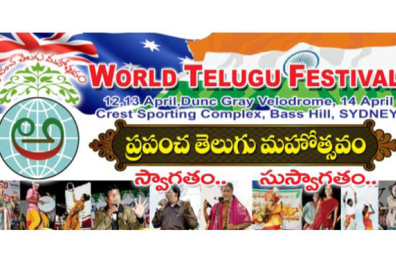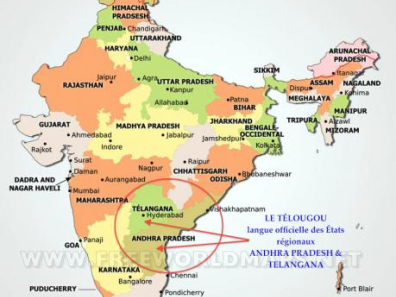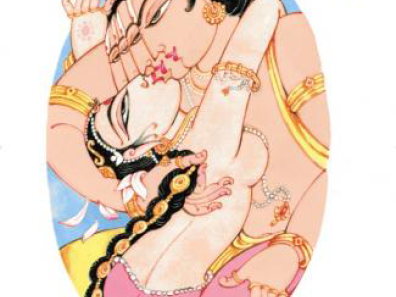Telugu (South India): did you say "rare language"? A journey of research and study.

A rare language?
Despite its vital demographic and cultural importance within its vast homeland, its existence is usually unknown elsewhere in the world to anyone unfamiliar with the Indian subcontinent. In turn, ignorance of the name itself helps to explain the small number of students who usually flock to its teaching each academic year, as does the administrative label "rare language" awarded to guarantee its institutional permanence, despite its major demographic and cultural importance within the immense terroir of origin.
However, this South Indian idiom is still spoken by some 100 million native speakers and, according to statistical data, ranks between second and fourth among India's languages. The country's federal constitution gives it national status, while a large Telugu diaspora, both ancestral and more contemporary, can be found in Malaysia, Mauritius, Arabia, the USA, Australia and the UK.
The institutional position of Telugu within the Indian Union means that it can hardly be called a "little-taught language", except to signify its international academic rarity. On this last point, as much as on that of its political importance, it remains to mention the regular organization of world symposia, conferences or colloquia (prapanca sadassu), and other international meetings (antarjātīya mahāsabha, prapanca mahāsabha), devoted since the 1970s to the language's literature, culture or history by various Telugu institutional circles, sometimes with the assistance or participation of the central government of India, not to mention similar pan-Indian national events.

A cultural language
Telugu has a distinguished cultural and literary history spanning ten centuries. The abundance of works produced between the 11th and 19th centuries conceals an extreme diversity of types, contents, stylistic or ideological orientations. Scholarly productions meet the rigorous codification requirements of a singularly sophisticated poetics, which is unique to this linguistic and civilizational domain. Their prosodic characteristics extend to the language and reveal aesthetic qualities celebrated by connoisseurs of the land for its incomparable mellifluousness: a 17th-century transalpine Jesuit described Telugu as "the Italian of the East".
Telugu literature has also been enriched in the modern and contemporary periods of the last two hundred years by a comparable variety in prose and poetry genres. This superabundance continues to promote parallel itineraries in the current modes of composition of works, with a volume of publication and literary manifestations of extreme vivacity.
It does not stop at the scholarly forms of the written word, but engages a very large number of purely or partially oral genres, sometimes published as well. Poetic orality is divided between purely sung types, narrative genres, theatrical styles and recitative modes that embrace the conditioning of caste society but are also constituted to disseminate the ultra-contemporary ideological or political messages of militancy.
Thus, the heritage of the Telugu literary domain alone seems properly phenomenal. Beyond that, language is at the heart of an immense culture, an aesthetic and identity factor as well as an ethical, political and religious driving force. This entire cultural universe offers considerable scope for investigation. At the same time, it suffers from a terrible international academic deficit, and remains a subject of study to be discovered for the most part1.
Our field of research was initially part of an ethnological approach, centered on an attempt at an analytical description of a theatrical narrative genre in the Telugu language of Andhra Pradesh, the burrakatha ("Burra Narrative"). The objective was part of a doctoral thesis, based on ethnographic work deeply rooted in a local and regional society governed by the Telugu linguistic fact. The study focused on all the constituent phenomena of this aesthetic form belonging to the contemporary popular universe (1940-2000).
We sought to situate the object in relation to the civilizational elements that could be associated with it at the diachronic and synchronic levels, endeavoring to fix the territorial space of reference that the genre allowed us to distinguish. This attempt at description placed the particular phenomenon within the encompassing socio-cultural system that had engendered it. It aimed to circumscribe the burrakatha in its own sphere of significance, and accounted for the functions of spectacular or participatory literary expression in living popular communication and culture.
The initial fieldwork of observation and oral interaction, together with the textual study of elements drawn from concomitant genre repertoires, gradually conditioned us to intensive, in-depth language learning in situ, in context, and from our own pedagogical resources, with no possible recourse to external institutional teaching that existed anywhere.
In doing so, we were also able, right from the start, to develop a method of learning and assimilating the language with local teaching masters that has served us continually ever since. It enabled us to learn the language, deepen our initial knowledge, gather information from the field and collect - some under dictation - the texts of the most representative stories in the target corpus.
The aim was to uncover, translate and shed light on essential unpublished data, primarily concerning the narrative genres we were working on, but also facts about culture, religion or society, including in the ideological or political spheres, in order to obtain a flattening of the particularisms specific to Telugu society in Andhra Pradesh. The work of deciphering continues, with the systematic deepening of knowledge, which requires a particularly assured command of the language.

Perfect mastery of Telugu is a prerequisite for understanding the popular language
One of the most arduous dimensions of satisfactory access to understanding the linguistic phenomena of any language lies in the ability to grasp the less sustained and more familiar oral forms of utterance that are enunciated in the uninterrupted succession of phonemes of the spoken chain, in a free and non-formal context. Dravidian languages are notoriously difficult in this respect. However, one of the particularly interesting features of popular narrative and theatrical forms is revealed in all its force when performed in public. This is a point of research as essential as it is problematic, that of access to observation of the facts of language (form and content) of non-formal discourse.
Or, humorous performers, those of social criticism too, frequently embody characters given as ordinary or vulgar in Telugu theatrical forms of expression. For the most part, they take center stage for comic or satirical purposes. Alongside the stylized poetic language of the central narratives or literary dialogues, they play with a spoken language of common usage, peppered with coarse language and social accents of low status.
These oral dimensions of irregular popular language very often constitute the bulk of textual expression in both narrative and theatrical performance, but generally remain unedited, especially the more salient ones. They vary according to audience, circumstance and, of course, era, in line with changes in language and society. Given on the spot, they offer no possible recourse to any publication whatsoever.
Since 1986-1990, we have had access to audiophonic and audiovisual recordings made in the field. Academic study of this type of discourse is extremely rare in the context of South Indian languages. The scientific interest is obvious. However, the analysis of non-normative discourse was by no means possible until we had the advanced linguistic skills needed to decipher the sentences phonetically.
The initial problem required unfailing linguistic knowledge. This naturally required exact, accurate and precise knowledge of Telugu-French semantic equivalence, both in terms of lexical meanings and idiomatic values of syntagms, governed by the extraordinarily foreign logical constructions of the grammatical structures of each of the two languages. The need therefore arose to systematically establish these resources. On the one hand, with the obvious exception of the target idiom itself, methods and aids for learning Telugu were virtually non-existent in French. Resources on the language were practically only available in English. On the other hand, even today, Telugu learning materials are not without significant shortcomings. English and French linguistic facts are also far from always overlapping. This applies both to syntactic forms, different categorizations of grammatical classes, and lexical morphology, which is highly grammaticalized - by agglutination, in Telugu.
The search for correct correspondences vis-à-vis concepts, expressions, and symbolic constructs (tropes, images or clichés), from linguistic universes with unrelated geographical and civilizational realities, added to the unthinking of unrecorded phenomena.
The approach to knowledge would require a step-by-step construction of the means of knowledge. The process of adequately realizing the equivalence relationships between Telugu and French could only be accomplished through an internalized cognitive mediation, of a mental order, between these two languages. It would inevitably involve the definitive sanctioning of the discursive processes of oral practice in context, through the test of viability, in the understanding of what is said and received, during the verbal exchange between interlocutors.
The orientation of this type of research was obviously at the heart of the need to foster the practice of learning and studying for current and future students. The aim was to build up a base of knowledge in French about Telugu, so as to satisfy the general conditions for immediate, high-quality language teaching, and then to enable the language to be passed on perennially from one generation to the next, from French-speaking expertise in the field, with the gradual development, currently underway, of pedagogical, grammatical and lexicographical works.
At the end of the day, the intensive learning of Telugu in practices of this type, the publication of a first basic bilingual dictionary, the pursuit of literary exploration, and the translation work required to exhaustively map out the lexical and grammatical meanings of the texts studied, have led us, over the long term, to an all-out consolidation of the gains made, during the initial fieldwork, and then during successive research activities. In this way, the conditions for the study of recording texts derived from living orality, by ourselves, or by students interested more specifically in this line of research, are now fulfilled.
Beyond the work undertaken on the more classical works of literary expression inscribed in publishing works or philological writing, with forms fixed in pre-written discourse, the field of the study of non-scholarly orality in the Telugu domain is open. It seems to us promising and fertile, if not indispensable, in terms of knowledge, for several disciplinary or areal purposes, especially for that of... oriental languages and civilizations at Inalco.
Daniel Negers
Lecturer in Telugu language and culture
_______________________________
1 The significance of linguistic and cultural phenomena is likely to be increased by heuristic possibilities with major additional contours on planes or towards a priori unexpected horizons, in India and in the diaspora today. On the one hand, while Telugu has its most distant origins in an ancient historical state of the Dravidian bedrock, and retains a logical and grammatical structure, as well as a considerable lexicographical background, deeply rooted in this linguistic family foreign to the Indo-European domain - and practically alone; with the slightly divergent exception of Malayalam, the language of Kerala - it has also built up a large volume of terminology and grammatical resources from Sanskrit. This was done either as it was, or in various forms of Teluguization (grammatical agglutination and other morpho-lexicological variations).
On the other hand, coupled with the effect of studies devoted primarily to the immediately neighboring Tamil world, the lack of knowledge about the bulk of the Telugu domain has probably hindered better recognition of the factors of influence it may have had on much of Southeast Asia, Indonesia and nearby Oceania in distant historical times.
An international expansion of practical Telugu studies could help to remedy this, based on comparative investigations, as it could bring to light kinships originating in the Telugu country (architectural field), and notably on the linguistic level at least already from the dual perspective of etymology and grammatical categories foreign to the Indo-European field, for phenomena that remain little, if any, described or analyzed, both within and outside the Dravidian field.